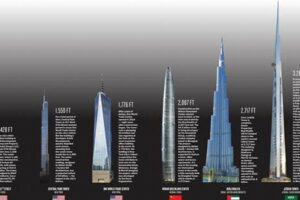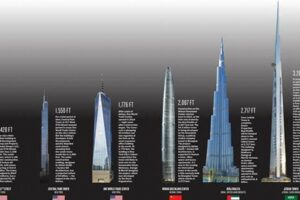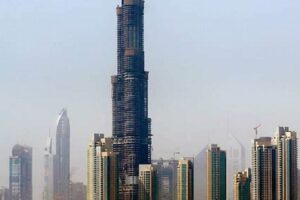Skyscrapers, towering structures that dominate skylines worldwide, are architectural marvels that push the boundaries of engineering and design. Among these giants, the tallest skyscraper stands as a symbol of human ambition and innovation, captivating the imagination and inspiring awe.
Determining the height of the tallest skyscraper is a complex endeavor that involves precise measurements and continuous updates as new structures emerge. Official organizations, such as the Council on Tall Buildings and Urban Habitat (CTBUH), meticulously track and verify the heights of buildings, employing advanced technologies like laser surveying and satellite imagery to ensure accuracy. The height of a skyscraper is typically measured from the base to the architectural top, excluding antennas and other non-permanent structures.
The quest to construct the tallest skyscraper has a long and storied history, driven by a desire to create iconic landmarks and showcase architectural prowess. Over the decades, various cities have held the title of housing the tallest building, with New York City, Chicago, and Dubai being notable examples. Today, the Burj Khalifa in Dubai stands as the undisputed champion, reaching an astonishing height of 828 meters (2,717 feet). This architectural masterpiece has held the title since its completion in 2010 and continues to be a global symbol of architectural achievement.
1. Measurement
When determining the height of a skyscraper, precision is paramount. Laser surveying stands as a crucial technique employed to gather accurate measurements. This technology emits laser beams that bounce off the building’s surfaces, calculating the distance and height based on the time it takes for the beams to return to the sensor. Laser surveying offers several advantages over traditional methods, including its accuracy, efficiency, and ability to measure complex structures. By utilizing laser surveying, architects, engineers, and construction professionals can obtain highly precise height measurements, ensuring the structural integrity and overall safety of skyscrapers.
The significance of precise height measurement extends beyond structural considerations. For skyscrapers vying for the title of the world’s tallest, every meter counts. Accurate measurements are essential for establishing and verifying the height of these architectural marvels, enabling fair competition and the recognition of true record-holders. Moreover, precise height measurements contribute to the skyscraper’s overall design and functionality, influencing factors such as wind resistance, material selection, and elevator systems.
In conclusion, the precise measurement of a skyscraper’s height is a critical aspect of modern architecture and engineering. Laser surveying provides a reliable and efficient means to determine the height of these towering structures, ensuring accuracy, safety, and fair competition. Understanding the connection between precise measurement and the determination of the tallest skyscraper highlights the importance of technological advancements in shaping the built environment.
2. Architectural Top
In determining the height of the tallest skyscraper, a crucial distinction is made between the architectural top and other structures, such as antennas. The architectural top represents the highest point of the building’s permanent architectural features, excluding non-permanent elements like antennas, flagpoles, and other temporary additions. This distinction is essential for ensuring fair and accurate comparisons of skyscraper heights.
- Structural Integrity: The architectural top serves as a reference point for assessing the building’s structural integrity and overall design. It provides a consistent basis for evaluating the building’s stability, wind resistance, and other engineering considerations.
- Architectural Expression: The architectural top reflects the architect’s vision and design intent. It represents the culmination of the building’s aesthetic and functional elements, contributing to its overall form and character.
- Height Comparisons: By excluding non-permanent structures like antennas, the architectural top provides a standardized measure for comparing the heights of skyscrapers. This ensures that the tallest skyscraper designation is based on the building’s core architectural features rather than temporary additions.
- Historical Context: Historically, the architectural top has been the primary reference point for determining the height of skyscrapers. This consistency allows for meaningful comparisons across different eras and architectural styles.
In conclusion, the architectural top serves as a crucial reference point for determining the height of the tallest skyscraper. It represents the highest point of the building’s permanent architectural features, excluding non-permanent structures. This distinction ensures fair and accurate comparisons, reflects the architect’s design intent, and provides a consistent basis for assessing the building’s structural integrity and aesthetic expression.
3. Competition
The quest to construct the tallest skyscraper is deeply intertwined with the competitive spirit among cities worldwide. This drive to reach new heights has resulted in the creation of iconic landmarks that reshape skylines and become symbols of urban pride and economic prowess.
The allure of being home to the tallest skyscraper extends beyond bragging rights. These architectural marvels attract global attention, boosting tourism, investment, and economic growth. Cities like Dubai, New York, and Shanghai have strategically utilized their tallest skyscrapers as centerpieces of ambitious urban development projects, transforming their skylines into instantly recognizable symbols of modernity and progress.
Moreover, the competition to construct the tallest skyscraper fosters innovation and pushes the boundaries of architectural design and engineering. Architects and engineers are constantly challenged to develop new technologies and materials to overcome the structural and technical complexities of building ever-taller structures. This pursuit of verticality has led to groundbreaking advancements in areas such as high-strength concrete, wind engineering, and sustainable design.
Understanding the connection between competition and the construction of the tallest skyscrapers provides insights into the complex relationship between urban development, economic growth, and architectural innovation. It highlights the role of iconic landmarks in shaping identities and driving progress.
4. Landmark Status
The extraordinary height of the tallest skyscraper transcends its physical presence, elevating it to the realm of iconic landmarks. These architectural marvels become symbols of urban identity, national pride, and architectural prowess. The pursuit of constructing the tallest skyscraper is intricately connected to the desire for global recognition and a place in history.
The height of the tallest skyscraper serves as a tangible measure of a city’s ambition and economic strength. It reflects the aspirations of a nation, showcasing its technological advancements and engineering capabilities. The Burj Khalifa, standing tall in Dubai, is not merely the world’s tallest building but also a symbol of the United Arab Emirates’ rapid economic growth and its emergence as a global hub. Similarly, the Shanghai Tower in China embodies the nation’s economicand technological prowess, becoming an iconic landmark on the Pudong skyline.
Beyond their symbolic value, the tallest skyscrapers also attract global attention and investment. They become major tourist destinations, drawing visitors from around the world to witness these architectural wonders. This influx of tourism contributes to economic growth and job creation, further solidifying the skyscraper’s status as a valuable asset to the city and nation.
Understanding the connection between landmark status and the height of the tallest skyscraper provides valuable insights into the complex relationship between architecture, national identity, and economic development. It underscores the importance of iconic landmarks in shaping cities and nations, driving innovation, and attracting global recognition. This understanding is crucial for policymakers, urban planners, and architects involved in the design and development of our built environment.
5. Engineering Feat
The pursuit of constructing the tallest skyscraper is inherently intertwined with pushing the boundaries of engineering and design. This relentless quest for verticality demands innovative solutions to complex structural and technical challenges.
- Advanced Materials: Constructing skyscrapers requires the development and utilization of advanced materials, such as high-strength concrete and lightweight alloys, to withstand the immense weight and wind loads associated with extreme heights.
- Structural Innovation: Engineers employ innovative structural systems, such as diagrid exoskeletons and tuned mass dampers, to ensure the stability and resilience of these towering structures.
- Wind Engineering: Understanding and mitigating the effects of wind is crucial in skyscraper design. Engineers conduct extensive wind tunnel testing and employ sophisticated wind analysis techniques to minimize structural sway and ensure occupant comfort.
- Sustainable Design: The construction of skyscrapers must also consider environmental sustainability. Architects and engineers incorporate energy-efficient systems, rainwater harvesting, and green facades to reduce the ecological impact of these massive structures.
The connection between engineering feats and the height of the tallest skyscraper is inseparable. Each new record-breaking structure represents a triumph of human ingenuity and engineering prowess. These architectural marvels stand as testaments to the relentless pursuit of innovation and the boundless potential of human creativity.
6. Height Verification
In the realm of supertall skyscrapers, precision is paramount. Organizations such as the Council on Tall Buildings and Urban Habitat (CTBUH) assume the critical responsibility of meticulously verifying skyscraper heights to ensure accuracy and maintain a definitive record of the world’s tallest structures.
The verification process employed by CTBUH is rigorous and involves multiple stages. Surveyors utilize advanced laser scanning technology to gather precise measurements from the base to the architectural top of each skyscraper. These measurements are then carefully analyzed and cross-checked to eliminate any potential errors.
The importance of height verification cannot be overstated. Accurate height measurements are not merely a matter of record-keeping; they are essential for ensuring the structural integrity and safety of these towering giants. Precise height data allows engineers and architects to assess wind loads, design effective evacuation plans, and implement appropriate safety measures.
Moreover, reliable height verification plays a vital role in fostering healthy competition among cities and developers striving to construct the world’s tallest skyscrapers. By establishing a standardized and transparent verification process, CTBUH ensures fair and impartial comparisons, preventing inflated or inaccurate height claims.
In conclusion, the meticulous height verification performed by organizations like CTBUH is an indispensable component of determining “how tall is the tallest skyscraper.” Accurate height measurements are crucial for ensuring structural safety, facilitating fair competition, and maintaining a credible record of the world’s architectural marvels.
7. Global Recognition
The extraordinary height of the tallest skyscraper transcends its physical presence, propelling it to the realm of iconic landmarks that attract global recognition and become major tourist destinations. This phenomenon is deeply intertwined with the concept of “how tall is the tallest skyscraper.” The allure of visiting and witnessing these architectural marvels firsthand draws visitors from around the world, eager to experience the awe-inspiring views and architectural ingenuity that these supertall structures offer.
The global recognition accorded to the tallest skyscraper translates into significant economic benefits for the city and nation where it is located. The influx of tourists eager to marvel at these architectural wonders stimulates local businesses, creates employment opportunities, and contributes to the overall economic growth of the region. The Burj Khalifa in Dubai serves as a prime example, attracting millions of tourists annually and generating substantial revenue through its observation decks, luxury hotel, and retail spaces.
Furthermore, the global recognition of the tallest skyscraper extends beyond tourism and economic benefits. These architectural feats often become symbols of national pride and technological prowess, showcasing a country’s ambition and innovation on a global stage. The Shanghai Tower in China, for instance, stands as a testament to the nation’s economic and technological advancement, attracting international attention and recognition.
In conclusion, the global recognition and tourist attraction status of the tallest skyscraper are integral components of understanding “how tall is the tallest skyscraper.” These factors contribute to the economic vitality of the surrounding area, foster national pride, and showcase architectural innovation on a global scale. Recognizing this connection provides valuable insights for urban planners, architects, and policymakers involved in the development and design of our built environment.
8. Historical Context
The relentless pursuit of constructing ever-taller skyscrapers is deeply rooted in human history, mirroring our fascination with innovation, ambition, and architectural prowess. Understanding this historical context is vital for grasping the significance of “how tall is the tallest skyscraper.”
- Architectural Milestones: The quest for the tallest skyscraper has served as a catalyst for architectural innovation, pushing the boundaries of design and engineering. From the ancient pyramids of Giza to the Gothic cathedrals of medieval Europe, each era has witnessed iconic structures that redefined the limits of height and construction techniques.
- Technological Advancements: The evolution of the tallest skyscraper is inextricably linked to technological advancements. The invention of the elevator, steel-frame construction, and reinforced concrete enabled architects and engineers to overcome structural challenges and ascend to new heights.
- Cultural Symbolism: Skyscrapers have often carried cultural and symbolic significance, representing power, wealth, and national pride. The Empire State Building in New York City, for instance, became an enduring symbol of American resilience during the Great Depression.
- Global Competition: The quest for the tallest skyscraper has sparked a friendly competition among cities worldwide, with each vying to construct the most iconic and awe-inspiring structure. This competition has fostered innovation and driven architectural progress to unprecedented levels.
In conclusion, the historical context of the quest for the tallest skyscraper provides a rich tapestry of architectural milestones, technological advancements, cultural symbolism, and global competition. This historical perspective enhances our understanding of “how tall is the tallest skyscraper” by illuminating the factors that have shaped the evolution of these architectural marvels.
Frequently Asked Questions about “How Tall is the Tallest Skyscraper”
This section addresses frequently asked questions to provide a deeper understanding of the topic. Each question is answered concisely and informatively.
Question 1: What factors determine the height of a skyscraper?
The height of a skyscraper is primarily determined by architectural and structural considerations. These include the building’s intended use, the available construction materials and technologies, and the local building regulations and zoning laws.
Question 2: How is the height of a skyscraper measured?
The height of a skyscraper is typically measured from the base of the building to the top of its architectural features, excluding antennas and other non-permanent structures.
Question 3: What is the current tallest skyscraper in the world?
As of 2023, the Burj Khalifa in Dubai, United Arab Emirates, holds the title of the world’s tallest skyscraper, standing at an impressive height of 828 meters (2,717 feet).
Question 4: What are the benefits of constructing tall skyscrapers?
Skyscrapers offer several benefits, including increased land utilization, improved energy efficiency, stunning views, and iconic landmarks that boost tourism and economic growth.
Question 5: What are the challenges associated with building skyscrapers?
Constructing skyscrapers poses significant challenges, such as structural stability, wind resistance, fire safety, and efficient elevator systems. Engineers and architects must carefully address these challenges to ensure the safety and functionality of these towering structures.
Question 6: What does the future hold for skyscraper construction?
The future of skyscraper construction is expected to focus on sustainability, innovation, and technological advancements. Architects and engineers are exploring new materials, construction methods, and energy-efficient designs to create even taller and more sustainable skyscrapers.
These FAQs provide a comprehensive overview of the topic and address common questions that arise when discussing the height of skyscrapers. Understanding these factors deepens our knowledge and appreciation for these architectural marvels.
Transition to the next article section…
Tips for Understanding “How Tall is the Tallest Skyscraper”
Comprehending the concept of “how tall is the tallest skyscraper” requires a multifaceted approach. Here are some valuable tips to enhance your understanding:
Tip 1: Grasp the Historical Context
Explore the historical evolution of skyscrapers to appreciate the advancements in architectural design and engineering that have made extreme height possible.
Tip 2: Understand Measurement Techniques
Familiarize yourself with the methods used to accurately measure the height of skyscrapers, ensuring reliable and consistent data.
Tip 3: Recognize Architectural Considerations
Understand the architectural elements and structural systems that contribute to a skyscraper’s height, stability, and functionality.
Tip 4: Consider Engineering Challenges
Appreciate the engineering feats involved in constructing skyscrapers, including wind resistance, seismic stability, and fire safety.
Tip 5: Explore Global Examples
Examine notable skyscrapers worldwide, studying their architectural designs, heights, and the factors that have influenced their construction.
Tip 6: Follow Industry Trends
Stay updated on the latest advancements and trends in skyscraper construction, including sustainable design, innovative materials, and technological breakthroughs.
Tip 7: Engage with Experts
Consult with architects, engineers, and industry professionals to gain insights into the complexities and intricacies of skyscraper design and construction.
Follow these tips to deepen your understanding of “how tall is the tallest skyscraper,” unlocking a fascinating world of architectural marvels and engineering achievements.
Proceed to the article’s conclusion…
Conclusion
The exploration of “how tall is the tallest skyscraper” unveils a captivating world of architectural ingenuity and engineering prowess. Skyscrapers, reaching extraordinary heights, stand as testaments to human ambition and innovation. Understanding their height involves precision measurements, architectural considerations, and an appreciation for the historical evolution of these iconic structures.
The pursuit of constructing ever-taller skyscrapers continues to drive advancements in design and engineering. As we look towards the future, sustainability, technological innovations, and a focus on human well-being will shape the next generation of these architectural marvels. The quest for the tallest skyscraper is not merely a race for height but a testament to our collective desire to push the boundaries of what is possible and create structures that inspire and connect people around the world.







